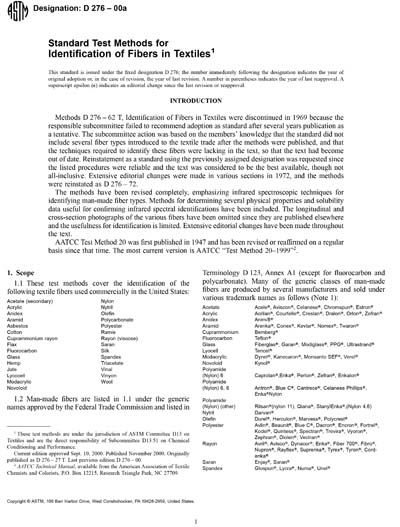Historical
ASTM D276-00a
Standard Test Methods for Identification of Fibers in Textiles
1.1 These test methods cover the identification of the following textile fibers used commercially in the United States:
| Acetate (secondary) | Nylon |
| Acrylic | Nytril |
| Anidex | Olefin |
| Aramid | Polycarbonate |
| Asbestos | Polyester |
| Cotton | Ramie |
| Cuprammonium rayon | Rayon (viscose) |
| Flax | Saran |
| Fluorocarbon | Silk |
| Glass | Spandex |
| Hemp | Triacetate |
| Jute | Vinal |
| Lycocell | Vinyon |
| Modacrylic | Wool |
| Novoloid |
1.2 Man-made fibers are listed in 1.1 under the generic names approved by the Federal Trade Commission and listed in Termninology D123, Annex A1 (except for fluorocarbon and polycarbonate). Many of the generic classes of man-made fibers are produced by several manufacturers and sold under various trademark names as follows (Note 1):
| Acetate | Acele, Aviscon, Celanese, Chromspun, Estron |
| Acrylic | Acrilan, Courtelle, Creslan, Dralon, Orlon, Zefran |
| Anidex | Anim/8 |
| Aramid | Arenka, Conex, Kevlar, Nomex, Twaron |
| Cuprammonium | Bemberg |
| Fluorocarbon | Teflon |
| Glass | Fiberglas, Garan, Modiglass, PPG, Ultrastrand |
| Lyocell | Tencel |
| Modacrylic | Dynel, Kanecaron, Monsanto SEF, Verel |
| Novoloid | Kynol |
| Polyamide | |
| (Nylon) 6 | Caprolan,Enka, Perlon, Zefran, Enkalon |
| Polyamide | |
| (Nylon) 6, 6 | Antron, Blue C, Cantrece, Celanese Phillips, Enka Nylon |
| Polyamide | |
| (Nylon) (other) | Rilsan(nylon 11), Qiana, StanylEnka,(Nylon 4,6) |
| Nytril | Darvan |
| Olefin | Durel, Herculon, Marvess, Polycrest |
| Polyester | Avlin, Beaunit, Blue C, Dacron, Encron, Fortrel, Kodel, Quintess, Spectran, Trevira, Vyoron, Zephran, Diolen, Vectran |
| Rayon | Avril, Avisco, Dynacor, Enka, Fiber 700, Fibro, Nupron, Rayflex, Suprenka, Tyrex, Tyron, Cordenka |
| Saran | Enjay, Saran |
| Spandex | Glospun, Lycra, Numa, Unel |
| Triacetate | Arnel |
| Vinyon | Avisco, Clevyl, Rhovyl, Thermovyl, Volpex |
Note 1--The list of trademarks in does not include all brands produced in the United States or abroad and imported for sale in the United States. The list does not include examples of fibers from two (or more) generic classes of polymers spun into a single filament. Additional information on fiber types and trademarks is given in References (1,2, and 3).
1.3 Most manufacturers offer a variety of fiber types of a specific generic class. Differences in tenacity, linear density, bulkiness, or the presence of inert delustrants normally do not interfere with analytic tests, but chemical modifications (for such purposes as increased dyeability with certain dyestuffs) may affect the infrared spectra and some of the physical properties, particularly the melting point. Many generic classes of fibers are sold with a variety of cross-section shapes designed for specific purposes. These differences will be evident upon microscopical examination of the fiber and may interfere with the measurements of refractive indices and birefringence.
1.4 Microscopical examination is indispensable for positive identification of the several types of cellulosic and animal fibers, because the infrared spectra and solubilities will not distinguish between species. Procedures for microscopic identification are published in AATCC Method 20 and in References (4-12).
1.5 Analyses by infrared spectroscopy and solubility relationships are the preferred methods for identifying man-made fibers. The analysis scheme based on solubility is very reliable. The infrared technique is a useful adjunct to the solubility test method. The other methods, especially microscopical examination are generally not suitable for positive identification of most man-made fibers and are useful primarily to support solubility and infrared spectra identifications.
1.6 This includes the following sections:
| Section | |
| Referenced Documents | 2 |
| Birefringence by difference of refractive indices | 34, 35 |
| Termninology | 3 |
| Density | 24- 27 |
| Infrared Spectroscopy, Fiber Identification by | 17-23 |
| Melting Point | 28-33 |
| Microscopical Examination, Fiber Identification by | 9, 10 |
| Reference Standards | 7 |
| Sampling, Selection, Preparation and Number of Specimens | 6 |
| Scope | 1 |
| Solubility Relationships, Fiber Identification Using | 11-16 |
| Summary of Test Methods | 4 |
| Significant and Use |
1.7 This standard does not purport to address all of the safety concerns, if any, associated with its use. It is the responsibility of the user of this standard to establish appropriate safety and health practices and determine the applicability of regulatory limitations prior to use. See Note 3.
ASTM International [astm]

